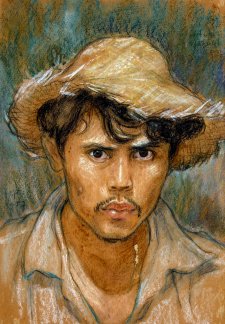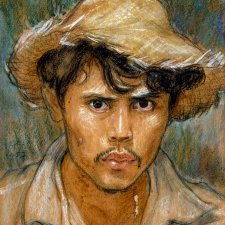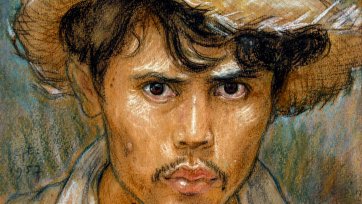Masters of Modern Indonesian Portraiture
Christine Clark:
Masters of Modern Indonesian Portraiture is a major travelling initiative from the National Gallery of Indonesia. It shows a selection of their modern works from their collection as well as young artists who have been working in the last five years.
So what this exhibition shows is the very strong voice that occurred with artistic circles, like in the '30s, '40s and '50s, not wanting to follow what was happening in Europe or other countries but really wanted the voice that was Indonesian. They didn't want to beautify or exalticise their country, but really to talk about the everyday, what the everyday person was doing, and you see that in a lot of the works.
The artist Sudjojono is often known as a father of modern Indonesian art. He advocated that art should very much reveal the soul of the artist and the sitter. He wasn't just an artist, a very important art critic at the same time and he formed a group called PERSAGI and many of these artists are included in this exhibition.
Asikin Hasan:
S Sudjojono and his colleague didn't believe that represented of Indonesian reality. For them, it was talked as a colonial desire and exoticism. He attacked Mooi Indie style as the wrong way in the representation of Indonesian reality. Indonesian reality were the poor people and everyday life, just not beautiful mountains and landscape.
Affandi a very important figure in Indonesian modern art. Mainly Affandi painting title about self portrait.
Christine Clark:
Affandi discarded his brushes, far preferring to like use his fingers, dipping his fingers into the paint and applying those directly onto the canvas, and you see that energy very much appears in all of his works.
Hendra Gunawan is known for his expressive style. He often depicts also his subjects on the side, so in a lot of ways this also relates to the wayang figure.
Asikin Hasan:
This exhibition followed young artist nowadays. They are generation after Indonesia Reformation 1998. S Sudjojono states it is full spirit, "the brush is same as weapon to against colonialism."
Christine Clark:
A lot of contemporary art in the 1990s, this is before reformasi, the period of Reformation, was very like social and politically motivated, but since that time a lot of the artists are looking at a variety of themes, global themes, personal, collective identities, and we see this very much in the selection of works that we have here today.
[End of Transcript]







